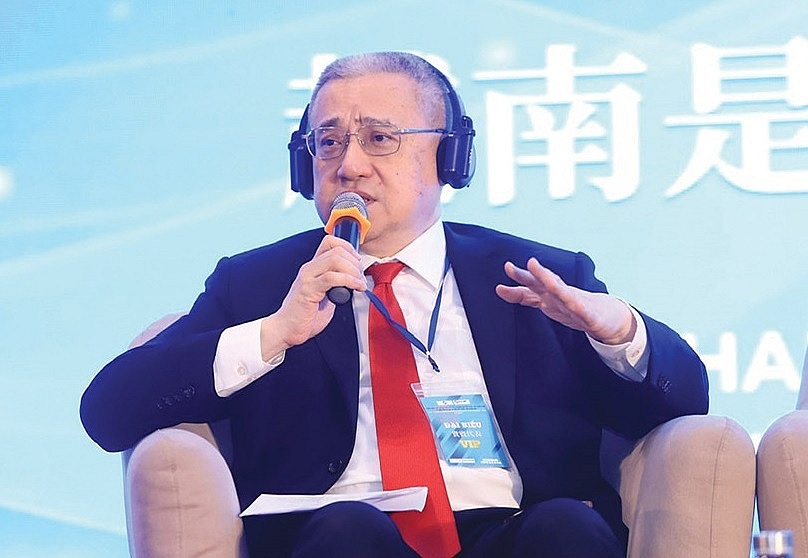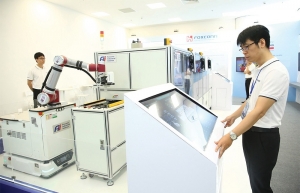Vietnam can emulate Taiwanese high-tech success
How do Taiwanese investors evaluate Vietnam’s investment environment in the context of production relocations around the globe?
 |
| CY Huang, chairman of the Southeast Asia Impact Alliance |
Vietnam is an attractive destination for Taiwanese investors and a crucial link in the Southeast Asian supply chain relocation trend.
The cultural similarities between Vietnam and Taiwan help reduce communication barriers and facilitate stronger conditions for investment cooperation. Furthermore, Vietnam’s young population, high economic growth rate, and diverse industries present opportunities for Taiwanese businesses to expand their investments.
Vietnam encourages and promotes Taiwanese businesses to invest in fields such as science and technology, electronics, and semiconductors, areas where Taiwan excels, and which align with Vietnam’s development direction.
What are the main expansion directions of Taiwanese businesses in Vietnam?
In the short term, almost all companies will continue to expand production capacity to meet the market’s increasing demand.
In addition, the manufacturers will merge upstream and downstream suppliers to reduce costs and improve efficiency. Thus, the relocation will continue to occur, many of which will move production facilities to Vietnam. Manufacturers will increase to recruit local talent to improve management efficiency and integrate into local society.
Previously, Taiwanese enterprises focused on the traditional sectors, such as garments and textiles, shoe leather, and plastic. However, they are now more renowned investors in terms of electronics, semiconductors, and precious machinery. In addition, they also pay attention to the consumption sector, in areas such as retail and tourism.
What can Taiwanese investors do to help Vietnam catch up with Industry 4.0 to shorten the process of industrialisation and modernisation?
Taiwanese investment capital can help Vietnam catch up with the Fourth Industrial Revolution, shortening the process of industrialisation and modernisation.
Taiwan is famous for its advanced technology industry, with a strong emphasis on research and development, manufacturing, and innovation. Taiwanese companies such as Foxconn, Taiwan Semiconductor Manufacturing Company (TSMC), and HTC have gained global recognition for their contributions to the ICT sector. They have a good foundation in hardware and software, and also have the ability to integrate hardware and software to form a total solution, this has become an important trend.
These advantages can help Vietnam develop smart cities and many other applications related to supporting industries. In addition, next-generation networks such as 5G are becoming software-defined, virtualised systems with cloud-based architectures. Many Taiwanese hardware manufacturers are seeking to collaborate with international partners to develop new telecommunications applications that could be sold in Taiwan and eventually be exported to other markets.
Furthermore, in February, Taiwan’s Ministry of Education announced the International Industrial Talents Education Special Programme for talent from Vietnam, Indonesia, and the Philippines coming to Taiwan for study and employment after graduation.
The programme will focus on training in sci-tech, chips, and semiconductors. Taiwan’s authorised agencies cover tuition fees and other administrative costs for up to two years. Participating companies provide each student with a living allowance of $320 per month, and students will have an additional allowance during their internship.
The training period is two years. After finishing the programme, international students will work for a minimum of two years for the Taiwanese business that supported them. Students can then choose to continue working in Taiwan or return to Vietnam.
Taiwan is currently the world leader in semiconductor manufacturing. What should Vietnam do to improve its standing in this area?
Vietnam is attractive to Taiwanese companies, whether in traditional manufacturing or high technology. However, in the semiconductor industry, Vietnam should have a more attractive incentive mechanism.
In reality, almost all semiconductor manufacturers are still focusing on developed countries. For example, TSMC is still expanding in the United States, Japan, and Germany. And one of the key reasons to retain this manufacturer is the government subsidy, as many governments offer a subsidy of at least half of the project’s total investment capital.
Japan is an example, where the government provided a subsidy of over $3 billion for the first investment phase of TSMC, equalling half of the project’s capital. The second subsidy for TSMC’s second phase is $5 billion. Germany has also made similar actions.
The other important factor is the high-quality labour force. Vietnam should build up more specific action plans for the strategy to train 50,000 engineers for the chips and semiconductors by 2030.
 | Capital influx from Taiwan builds up steam in Vietnam Many Taiwanese investors have plans to set down deep roots in Vietnam, especially in the high-tech sector. |
What the stars mean:
★ Poor ★ ★ Promising ★★★ Good ★★★★ Very good ★★★★★ Exceptional
Related Contents
Latest News
More News
- Global partnerships key to Vietnam’s IFC development (December 26, 2025 | 16:18)
- Vingroup pulls out of bid to invest in North-South high-speed railway (December 26, 2025 | 11:42)
- Strengthening supply chains through trade promotions and customs reform (December 24, 2025 | 14:00)
- PM orders investment model for North–South high-speed rail (December 22, 2025 | 17:43)
- LS Eco Energy to invest in Vietnam rare earth sector (December 22, 2025 | 17:31)
- Government moves to establish International Financial Centre (December 21, 2025 | 21:00)
- Vietnam's IFC to target global investment flows (December 21, 2025 | 18:00)
- Two national hospitals expand capacity with new facilities (December 20, 2025 | 09:00)
- Ha Tinh breaks ground on major Vingroup industrial and energy projects (December 19, 2025 | 18:24)
- EVN launches major power infrastructure projects nationwide (December 19, 2025 | 18:17)

 Tag:
Tag:





















 Mobile Version
Mobile Version